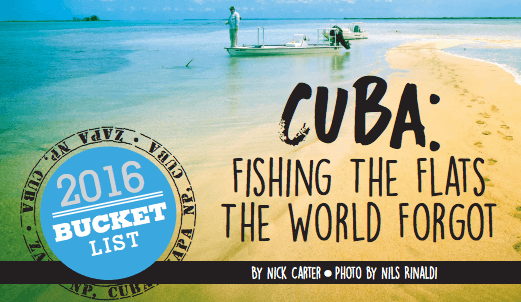For more than half a century, countless people have stood at the Southernmost Point Buoy in Key West and looked south across the Straits of Florida. Just 90 miles away is Cuba, the largest island in the Caribbean. Cuba has been called “the island the Western World forgot.” A 1960 embargo imposed after Fidel Castro’s rise to power cut off most U.S. trade and travel with this communist island nation. Outside of its tumultuous past learned in history class and the color, culture and adventure related to us through the words of Ernest Hemingway, Cuba to most U.S. citizens is just a place where they roll good cigars that are hard to get.
But it should come as no surprise that Cuba also offers fantastic fishing. With easy access to blue water currents of the Caribbean, big-game fishing is good—as one might expect. But flats fishing may be what sets Cuba apart from other destination fisheries. Marine parks of white-sand flats have been protected by the communist regime, and recreational fishing is tightly controlled by just a handful of companies. Imagine it—vast Caribbean flats with extremely limited fishing pressure. It’s an inshore fly angler’s dream. That dream is getting ready to become a reality for American anglers. Since the 1960 embargo, U.S. anglers who wanted to fish Cuba had to skirt the law. U.S. citizens are still prohibited by law from visiting the island as “tourists,” but rules on travel and business have relaxed since the Obama administration restored diplomatic relations in 2015.
Orvis, one of the largest fly fishing outfitters in the world, will be the first major U.S. sporting company to do business on the island. Starting in October, Orvis will begin offering monthly flats trips near Cienaga de Zapata National Park with local guides. The park is more than 1,000 square miles of pristine ecosystem that has been tightly controlled by the Cuban government for decades. The saltwater flats feature bonefish, tarpon, permit, snook and snapper that are rarely fished for. Park officials only allow eight anglers to fish the park at any one time. Orvis will offer packages from $6,150, not including airfare, for seven days. This package includes four days of flats fishing. The remaining days will be spent exploring the Cuban culture.
So, while the floodgates have not exactly opened up for American anglers who want to fish Cuba, it’s a start. Perhaps in the not-toodistant future an angler will be able to legally hop on a quick flight to fish places like Jardines de la Reina, Cayo Largo or La Salina at Bay of Pigs. As mentioned previously, strict protections for many of Cuba’s fisheries have created remarkable resources. At Jardines de la Reina, for example, commercial fishing and nets are not allowed, and access to even flats skiffs is limited to just one company, Avalon (cubanfishingcenters.com), which maintains exclusive rights to several inshore fisheries in Cuba.
Avalon offers resort-style trips as well as mothership-based trips in several of the island’s marine parks, where tarpon are large and permit, bonefish and barracuda are plentiful. It’s important to remember that just because U.S. citizens haven’t been allowed to vacation in Cuba doesn’t mean the rest of the world is cut off from the island. Cuba Welcome (cubawelcome.com) is a British travel agency that opened in Havana, Cuba in 2000. The agency promotes offshore fishing for marlin, sailfish, swordfish and many other species in the favorable currents that sweep past the island. But again, it comes back to the flats fishing. With access to several national parks where the daily number of anglers is strictly limited, they can offer fishing that’s as “virgin” as it gets. Traveling anglers in Cuba must be ready for some adventure. There are top-notch hotels and resorts, but the transportation and infrastructure are far behind what we are used to in the U.S. For many of us, adventure is half the fun. Before too long, names like Zapata National Park may become household for anglers. Perhaps that would be a shame.
